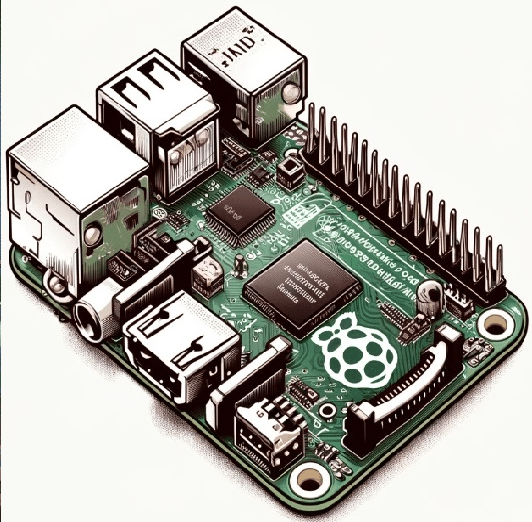With Raspberry Pi Ltd considering an Initial Public Offering, we look at what this kind of computer is, its value in promoting computer literacy, and what similar alternatives there are.

Raspberry Pi
Raspberry Pi, the most well-known Pi, is a series of small, affordable, single-board computers (SBCs) developed by the Raspberry Pi Foundation in the United Kingdom. It is a leader in low-cost, high-performance computing that has now been around for some time. For example, the first Raspberry Pi was introduced on 29 February 2012 and several models featuring improvements in performance, memory, and connectivity options have been introduced since then. The different models cater to a variety of user needs, from the basic Model A and A+ to the more advanced Model B and B+ series, and the high-performance Raspberry Pi 4.
Who Is It For?
The primary goal of the Raspberry Pi project is to promote the teaching of basic computer science in schools and developing countries. Also, as Eben Upton, CEO of Raspberry Pi points out, it was designed to be “affordable enough for young people to own and explore with confidence”.
Raspberry Pi is actually a subsidiary of the Raspberry Pi Foundation, which is a UK charity (founded in 2008), with the goal of promoting interest in computer science among young people.
Large Community
Raspberry Pi products (which are available in over 70 countries) actually enjoy a great deal of community support as they are backed by a large, active community of users and developers who share projects, tutorials, and software, facilitating learning and problem-solving.
Markets
Raspberry Pi says its products are actually sold in three principal markets: the Industrial and Embedded market, which in 2023 accounted for 72 per cent of unit sales, the Enthusiast and Education market, which in 2023 accounted for 28 per cent of unit sales, and the semiconductor market, which Raspberry Pi entered in early 2021 with the launch of its first semiconductor product ( the RP2040 microcontroller).
Raspberry Pi Vs Traditional Computers – What Are The Differences?
The main differences between a Raspberry Pi and other traditional desktop and laptop computers are:
– Size and form.
They are significantly smaller (often credit card-sized), making them ideal for space-limited projects.
– It’s much more affordable – ranging from £4 to £35, making it accessible to students and hobbyists.
– The difference in hardware.
For example, it comes as a bare circuit board, requiring users to connect their own peripherals like keyboard, mouse, and monitor.
– The operating system.
It typically runs a Linux-based OS, with Raspberry Pi OS being the most common, unlike the Windows or macOS on traditional computers.
– The GPIO pins, i.e. it features General-Purpose Input/Output pins for connecting and controlling external hardware like sensors and motors, ideal for DIY projects and hardware programming.
– Much lower power consumption, making it suitable for always-on or power-sensitive projects.
– Community and resources.
As mentioned above, it’s supported by a large, active community.
Why Is It In The News?
Raspberry Pi Ltd is in the news at the moment because it is considering an Initial Public Offering – it has announced its expected intention to float on the London Stock Exchange. Raspberry Pi has a strong track record of revenue growth and profitability and for the year ended 31 December 2023, revenues were $265.8 million. Although a valuation for the company hasn’t been officially announced, it’s been rumoured that £300 million+ doesn’t seem too unlikely.
Also, Raspberry Pi has made the news recently because:
– It has unveiled several new products, such as an AI camera kit featuring a 12MP Sony IMX500 sensor, a new 15.6-inch monitor with HDMI connectivity, and the long-awaited M.2 HAT for fast NVMe storage on the Raspberry Pi 5.
– The Raspberry Pi Foundation has significantly increased production of Raspberry Pi 5 units, with the goal of manufacturing up to 90,000 boards per week.
– A new Compute Module 5 (CM5) looks likely to launch soon.
Alternatives
Raspberry Pi is, however, not the only single-board computer or microcontroller out there, and these alternatives are typically aimed at (and used by) a variety of audiences, each with different applications in mind. Here are a few of the most popular SBC alternatives to Raspberry Pi:
– Arduino.
While not a direct competitor, Arduino boards are widely used in electronics projects and prototyping. Unlike the Raspberry Pi, Arduino is a microcontroller rather than a full computer. Models include the Arduino Uno, Arduino Mega, and Arduino Nano.
– BeagleBone.
BeagleBone boards are powerful single-board computers similar to the Raspberry Pi but often offer more I/O options and are used for more advanced projects. Models include the BeagleBone Black, and BeagleBone Green.
– Odroid.
These boards are known for their high performance and are suitable for applications requiring more computing power. Popular models include the Odroid XU4, Odroid C2, and the Odroid N2+.
– Banana Pi.
These boards are similar to Raspberry Pi in form factor and functionality but often come with additional features like more RAM or better network connectivity. Models include the Banana Pi M4, and Banana Pi M2 Zero.
– Rock Pi boards offer high performance and are compatible with a range of operating systems, including Linux and Android. Popular models include the Rock Pi 4, and Rock Pi X.
– NanoPi.
These boards are compact and affordable, catering to various applications from simple projects to more complex IoT solutions. Models include the NanoPi M4, and NanoPi Neo4.
– Orange Pi.
These boards are regarded as being versatile and budget-friendly and can be used for a range of applications similar to the Raspberry Pi. Popular models include the Orange Pi Zero, and Orange Pi PC.
What Does This Mean For Your Business?
The advancements in single-board computers (SBCs) like Raspberry Pi, along with similar devices (e.g. Orange Pi, Arduino, BeagleBone, and Odroid) are transforming the landscape for UK businesses across various sectors. These versatile and affordable tools offer significant value to different user groups, driving innovation and efficiency in multiple domains.
For educational institutions, for example, these devices provide an excellent platform for teaching computer science and STEM subjects. By incorporating SBCs into the curriculum, schools and universities can offer hands-on learning experiences that enhance students’ technical skills and creativity. This not only prepares students for future careers in technology but also fosters a culture of innovation from a young age.
In the realm of development and engineering, businesses can leverage the flexibility and cost-effectiveness of SBCs for rapid prototyping and product development. Whether it’s a startup developing new IoT solutions or an established company refining its automation processes, these devices enable quick iterations and testing at a fraction of the cost of traditional development platforms. The extensive community support and resources available for these devices further facilitate innovation and problem-solving.
Industrial applications also benefit significantly from the deployment of SBCs. For example, the robustness and adaptability of these devices make them ideal for creating custom automation systems, enhancing operational efficiency, and reducing costs. Businesses can implement tailored solutions for monitoring, control, and data analysis, improving productivity and decision-making processes.
The potential flotation of Raspberry Pi and the growth of its competitors like Arduino and BeagleBone could bring significant changes to the market. Increased capital from public offerings would enable these companies to accelerate their innovation cycles, enhance their product offerings, and expand their market reach. This competitive environment could lead to more advanced, cost-effective solutions, benefiting consumers and businesses alike.
For businesses considering the adoption of SBCs, the stability and growth prospects of these companies are likely to mean continued support and development for their platforms. This assurance can encourage more extensive integration of these devices into business operations, knowing that they are backed by financially robust and innovative companies. Moreover, the diverse ecosystem of SBCs ensures that businesses can choose the most suitable device for their specific needs, whether it’s for educational purposes, development, or industrial applications.
By Mike Knight
